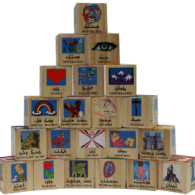Profile
It is hard to think of another endangered alphabet that has been used to write as many languages, and over as wide a geographical area, as Syriac.
The Syriac language is a literary variety of Aramaic, the lingua franca of much of the Near East from about seventh century BCE until the seventh century CE. Aramaic was thus also the language spoken by Jesus, and as the Syriac script superseded the Aramaic script over the first four or five centuries CE, versions of Syriac became the official scripts of Christianity wherever Aramaic was spoken.
As Eastern Christianity expanded, it took the Syriac script eastward, establishing communities in India (the Saint Thomas Christians), among the Mongols in Central Asia and in China, which became home to a thriving community under the Tang dynasty from the seventh to the ninth century. Between the ninth and fourteenth centuries, the Church of the East was, in sheer acreage, the world’s largest Christian church, and the Syriac script appears in an astonishing number and variety of documents of the time.
As the de facto script of learning, Syriac was used for many of the documents of early Christianity and many translations of works from Arabic, in addition to Christian hagiographies, chronicles and numerous theological works.
But having a script whose fate is tied to a religion is both a strength and a potential weakness. The rise of Islam saw Syriac replaced by Arabic in much of the Middle East, and when the Ming Dynasty overthrew the Mongols, Christians were expelled from China.
Today, then, the Syriac script is in an ambiguous position. It is still the active liturgical script of many minority communities in the Middle East, southeast India, and wherever Syrians have established religious communities overseas, especially in Europe, Australia and the Americas. As such, it enjoys a protected status within the church, and moreover, the wealth of historical documents in Syriac makes them an important field of study – so unlike other endangered alphabets, the cultural freight of Syriac is unlikely to be lost.
Yet very few Syrian speakers use the script daily, and it is very seldom taught. The future of the Syriac script, like the future of Syria itself, remains uncertain. It’s worth noting, though, that a number of organizations in Syria have included Syriac script on their signage, another illustration of the way in which a script can have an iconic richness that transcends the meanings of words.
You can help support our research, education and advocacy work. Please consider making a donation today.
Links
General Script, Language, and Culture Resources
Community Resources
- Syriac Aramaic Lessons Facebook
- Radio Malankara
- Radio Beth Gazo – Syriac Hymns
- The Syriac Institute
- Syriac Digital Library
- Scriptsource
- Syriac Aramaic Studies Facebook
Font/Keyboard Resources
Gallery
Sponsor
“Dedicated to the memories of Yousef Maroun ‘Joe’ El-Khouri and Rose Marie El-Khouri (née Isaac)”
—Michael Shiver













